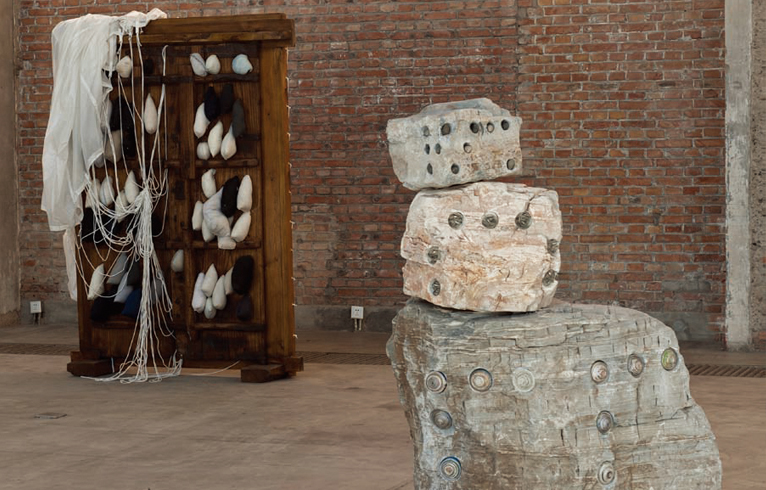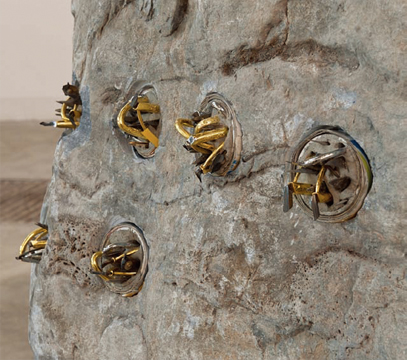NARI WARD: SEMIOTIC HIJACKING
| April 2, 2012 | Post In LEAP 13

NARI WARD IS a Jamaican-born installation artist whose work forges new semiotic possibilities for our relation to objects. Ever since his breakthrough work Amazing Grace (1993), in which he amassed nearly 300 abandoned baby carriages from Harlem streets and bound them together with fire hose in a disused firehouse, the “reinvention” of found materials has become a telling trademark of Ward’s artistic mission. His dramatic manipulation of urban detritus has seen wheelchairs flattened, their seats replaced with the ends of church pews, an ambulance painted over in translucent white and filled with smoke, a liquor store sign rearranged to spell “soul” and adorned with funeral flowers, and an entire wall of the backs of television sets draped with facial tissue.
This particular talent for psychological subversion has won him solo shows at MASS MoCA and the Walker Art Center, as well as group shows at the Guggenheim and Kunsthalle Zurich. For “10 Hands 100 Fingers,” Ward’s second group exhibition at Galleria Continua Beijing, the artist commandeered old doors by stuffing them with pants pockets full of feathers and “dropping” them into the space, punctured a giant stone with fractured scissors, and in a nod to much of his previous work, created a site-specific installation with old, discarded shoes. LEAP was fortunate to speak with the artist before he returned to New York, where he has lived and worked for more than two decades.
LEAP There is a misconception that China is an entirely homogenous nation (in fact, there are 56 recognized ethnicities in China, not to mention the stunning degree of linguistic and even culinary diversity here). It could be said that in stressing diversity, this exhibition almost reinforces that notion. How did you confront this theme?

NARI WARD The theme of diversity and understanding is one of the major aspects of the exhibition. We all agreed to participate in the exhibition because it is not just a conventional group exhibition. The artists wanted to build the show together and work to find ideas, which connect or created engaging tension. This was at times difficult since we all have our own vision and expectations. We decided that things could coexist even if they seemed unrelated as long as the questions they asked were thought-provoking. If there were disagreements, the group would confer on the issues and come up with a reasonable solution. Some of the artists, like myself, thought of projects which would allow for creating a condition or experience for the viewer, while considering the space as a situation for different ideas to emerge.
LEAP No matter where you show, your installations are almost unanimously created with local found materials, a practice you began when you moved to Harlem, New York. How do you approach this in foreign places with which you are not so familiar?
NW In exhibitions away from my home/studio I have to work closely with the gallery or organization that invites me to create the work. I usually have a wish list of materials and they search out the items and send me detailed images of the various selections available. The title of the exhibition “Beijing Online Inlive 10 Hands 100 Fingers” addresses this aspect of working both offsite and site-specifically with the support of many individuals.
LEAP China has a tradition of reconstruction, of rebuilding itself through architecture. This, of course, brings with it plenty of demolition. Was it easy to find the materials for this show?
NW Yes, especially things that are deemed old or cast-off.
LEAP Found objects have their own histories— both individual and collective— and your deployment of these objects grants them yet another. Is there a consistent relationship with “your” history and the “original” histories?
NW I am never quite certain what objects will inspire a situation or narrative. Some things I choose to work with usually start with a question about their status or meaning in a particular context and I work to hijack or reinvent their possibility. I try to start with things that are very familiar or mundane in order to give the viewer an immediate connection to the work.
LEAP Much of your work has been deemed spiritual. But at the same time, it often seems to guide viewer cognizance to the ground. (And even if not inextricably associated with the ground— shoes, tires, wheelchairs— I assume a good percentage of your materials have at least been found on the ground, too.) Is this intended to be a turn away from the globally ubiquitous rhetoric of heaven-as-upwards?

NW That is an interesting take on my work and one I never thought about in that way. I think my relationship to the ground has to do with endowing the work with a sense of autonomy. What is the object’s relationship to space, gravity, and our body? How can that dialogue be expanded upon or called to question? If one is to have a discourse about spirituality they have to come to terms with the present moment or offer some kind of connectivity to it. The idea of the ground is the easy reality or the known moment, which I am attempting to fracture in order to invite alternate possibilities.
LEAP Though not the case with this exhibition, shoes and shoelaces recurrently “materialize” in your work. Can you expound on this?
NW I usually try to introduce a part of the shoe as a whisper of presence. They have become a way to introduce the body or an anonymous mass of people in a very discreet manner.
LEAP Does your practice hold form above representation, or representation above form?
NW Both of these possibilities are relevant and the concept and questions in the work guides the choice of which becomes more prevalent for the viewer.
LEAP In this show, you have found, revamped, and retooled unhinged doors— essentially, doors eternally “open.” And this you have done as a foreigner in China, a country that has a long and frustrating relationship with Open Door Policy… is there a connection here?
NW Not specifically but I do see how that could be an interpretation of the work, especially since I chose the used doors as a metaphorical symbol of opportunity, which has been parachuted, or air dropped, into the gallery space. They are posturing the possibility of comfort, with the insertion of numerous feathered down stuffed pants pockets, but can only offer a temporary place to rest while perpetually trying to find a space to belong.
LEAP Hand Commands (Turn Left), in terms of both language and material, plays off of the Han-dynasty game of chance: rock, paper, scissors. Is there any kind of chance taken here?
NW Rock, paper, scissors is a game of chance, however, there is also a nonrandom approach to the game when played over a long period of time. It is this fact, which lead to me wanting to use it to question intuition, strategy, and the decision-making process. The trail markings give tribute to the idea of competition (with chance in the mix) as well as collaboration (with faith in the mix).
LEAP And through these trail marking codes, the piece directs the viewer to turn left. But which direction are we supposed to face in the first place?
NW Perhaps a direction of looking towards one another in order to learn more about ourselves.

